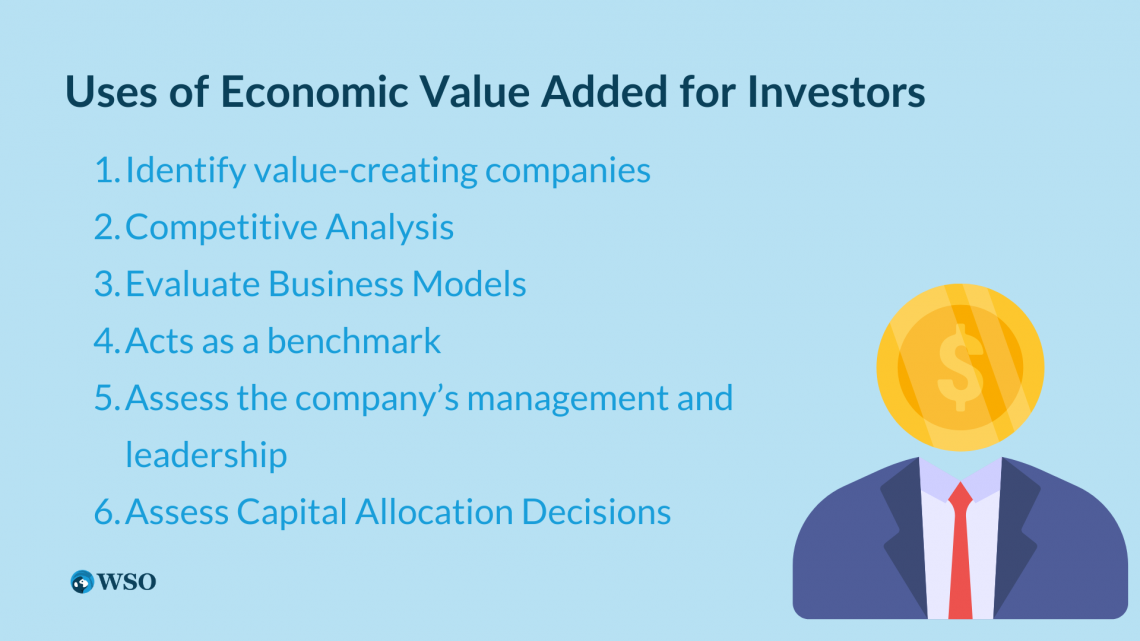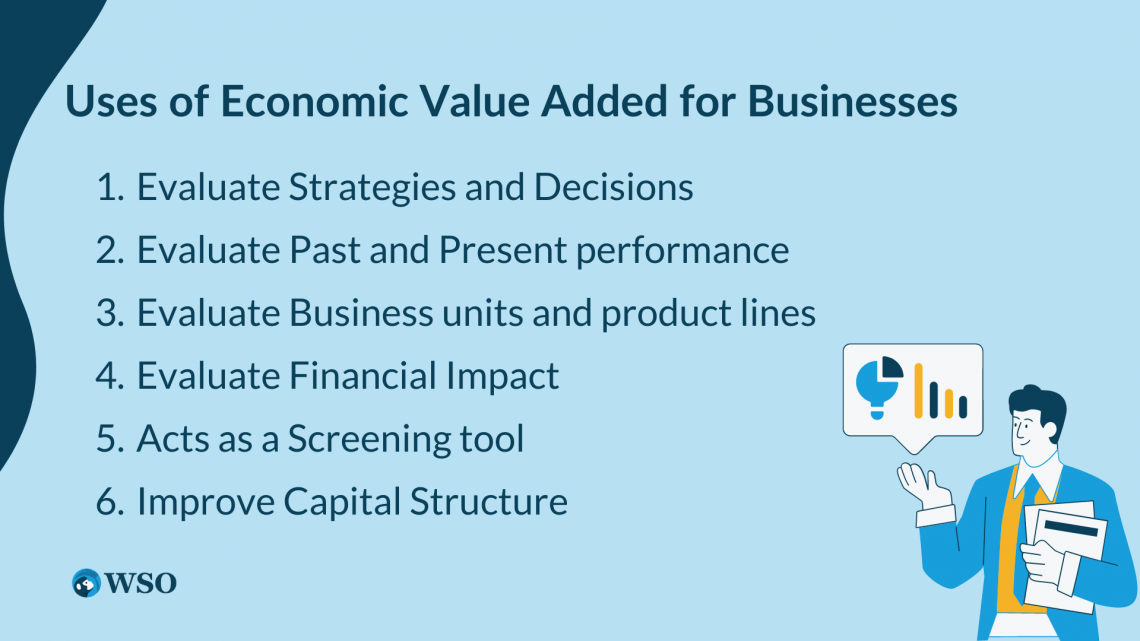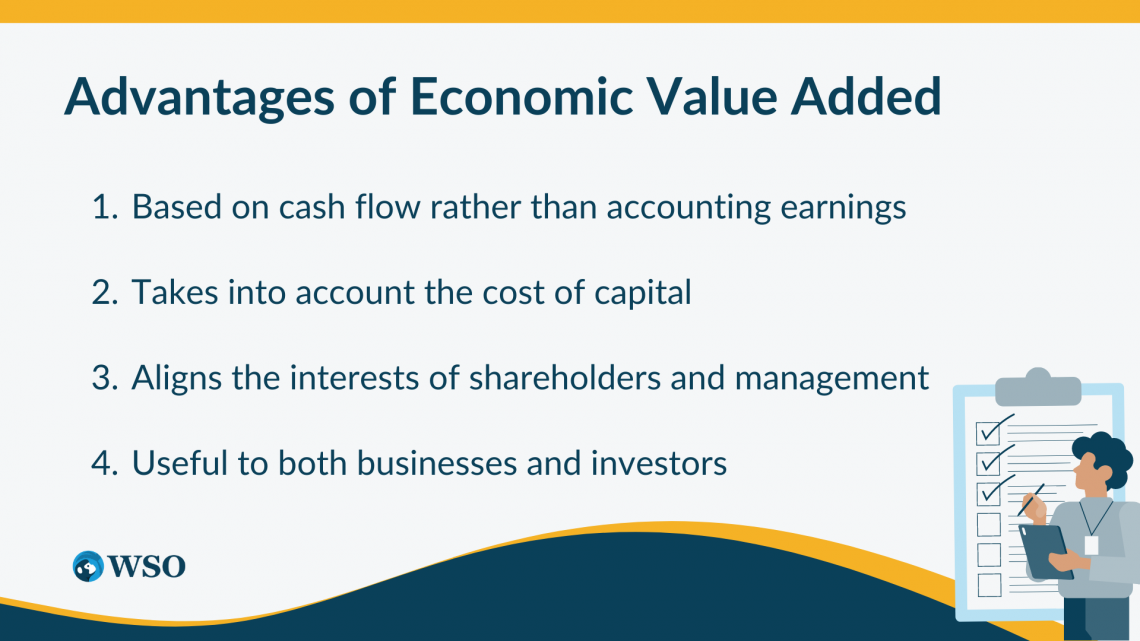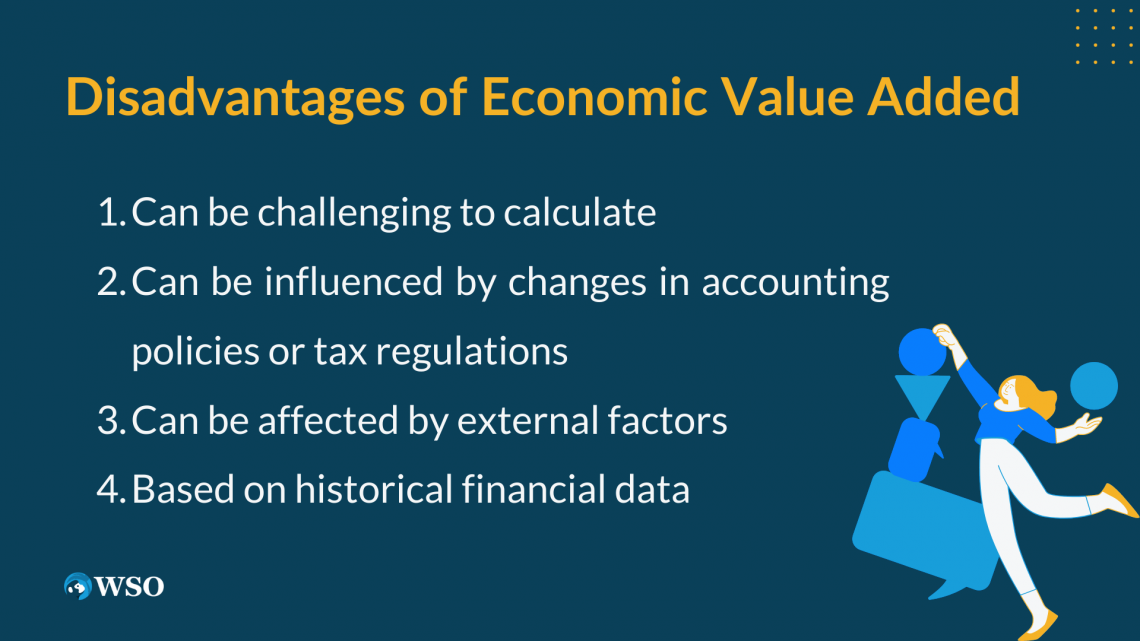Economic Value Added (EVA)
Value created in excess of the required return of the company's shareholders
Developed by Stern Stewart & Co. in the late 1980s, Economic Value Added estimates a firm's Financial Profit or the value created more than required by the Shareholders. The financial performance of the business is based on its Residual Income.

Economic Value Added, aka Economic Profit, was developed to provide a more precise measure of a company's financial performance and the value it creates for its shareholders than the traditional accounting metrics like net income or EPS.
The whole concept of this metric is based on the idea that the company’s highest priority must be to create value for its shareholders. This “value” must be in the form of profits generated. They must exceed the cost of capital used to generate those profits.
Both investors and the business use this metric for various reasons discussed later.
Investors utilize this indicator using an Outside-in perspective, which means they use it to evaluate a company's financial performance, which helps investors obtain insights about its capacity to produce value for its owners.
Whereas businesses themselves use the Inside-out approach, which means that they use this metric to assess the effectiveness of strategies. This helps identify the sources of their value creation and determine which strategies generate the most value for their shareholders.
Key Takeaways
- EVA is used to assess the value created by a company over its required return. It focuses on measuring how effectively a company utilizes its resources to generate profits.
- Economic Value Added (EVA) measures a company's financial performance accurately. It focuses on creating shareholder value through generated profits by subtracting the Cost of Capital from NOPAT.
- Positive EVA indicates value exceeding the cost of capital. At the same time, Negative EVA means the firm doesn't cover its capital costs, and if it’s zero, then it means no shareholder value is created.
- It determines which strategies generate the most value for shareholders.
- It provides a more comprehensive view of a company's profitability than traditional accounting measures, such as net income or earnings per share. It considers the cost of capital and emphasizes value creation for shareholders.
The formula for Economic Value Added
To calculate EVA, the firm must subtract the Cost of Capital from the firm’s NOPAT.

If the result is positive, the company is generating more value than the cost of its capital.
Economic Value Added= NOPAT - (Capital Invested*WACC)
Let's discuss each component of the formula in detail.
Let us first understand what NOPAT is.
Net Operating Profit After Taxes (NOPAT) is a financial metric that measures a company's operating profit after deducting taxes but before including interest expenses. It is calculated by subtracting operating expenses from revenues and then subtracting taxes.

Moving on to Invested Capital refers to all the money and assets put into a business or investment. It represents the financial resources and things of value that are used to make the business work and grow. It's like the fuel that powers the success of the business.
To calculate invested capital, the equity and debt market value is added together and adjusted for the company's cash or cash equivalents.
Invested Capital = Total Assets – Non-Interest Bearing Current Liabilities.
NOTE
Non-Interest Bearing Current Liabilities are liabilities that do not carry an interest rate, such as accounts payable)
Lastly, the Weighted Average Cost of Capital (WACC) is the combined cost of borrowing money and attracting investors for a company. It represents the minimum return required to satisfy lenders and investors, guiding financial decisions and project evaluations.
WACC = (E/V x Re) + (D/V x Rd x (1 - T))
Where:
- E = Market value of the company's equity
- D = Market value of the company's debt
- V = Total value of the company (E + D)
- Re = Cost of equity
- Rd = Cost of debt
- T = Tax rate
Calculation of Economic Value Added
Let us take an example to understand the calculation better.

Consider the following financial information for ABC Company to calculate its EVA:
- Net income: $800,000
- Total assets: $10,000,000
- Current liabilities: $2,500,000
- Long-term debt: $4,000,000
- Equity: $3,500,000
- Cost of debt: 7%
- Cost of equity: 10%
- Tax rate: 25%
To calculate EVA, we need to follow the steps below:
1. Calculate the company's net operating profit after taxes (NOPAT)
NOPAT = Net Income + [Interest Expense × (1 - Tax Rate)]
NOPAT = $800,000 + [$4,000,000 × (1 - 0.25)] = $2,800,000
2. Determine the company's total invested capital
Invested Capital = Total Assets - Current Liabilities - Non-Interest Bearing Current Liabilities + Long-Term Debt + Equity
Invested Capital = $10,000,000 - $2,500,000 - $0 + $4,000,000 + $3,500,000 = $15,000,000
3. Calculate the weighted average cost of capital (WACC)
WACC = (Cost of Equity × Equity / Invested Capital) + (Cost of Debt × Debt / Invested Capital) × (1 - Tax Rate)
WACC = (0.10 × $3,500,000 / $15,000,000) + (0.07 × $4,000,000 / $15,000,000) × (1 - 0.25) = 0.0835 or 8.35%
4. Finally, calculate EVA
EVA = NOPAT - (WACC × Invested Capital)
EVA = $2,800,000 - (0.0835 × $15,000,000) = -$175,000
Therefore, ABC Company's EVA is -$175,000. In addition to calculating the EVA for ABC Company, it is essential to interpret the result in the context of the company's financial performance.

A negative EVA indicates that the company needs to generate more returns to cover the cost of its capital. This may signal a need for improvements in operational efficiency, profitability, or strategic decision-making.
If the result had been positive, then it would've meant that the company was generating more value than the cost of its capital. If the EVA = 0, then it means that the company creates no shareholder value.
Uses of Economic Value Added for Investors
This profitability metric has various advantages, which will be discussed later. However, one of the major advantages of this metric is that it is used by Investors and Businesses for various purposes, as discussed below.

For investors, the uses are:
1. Identify value-creating companies
Economic Value Added helps potential and existing investors identify companies that create the most value for their shareholders and make more informed financial decisions.
2. Competitive Analysis
Investors use this metric by comparing the EVAs with their competitors and benchmarks; this further helps them gain industry insights into the various risks and competitive positions.
3. Evaluate Business Models
Economic Value Added can be used, along with other metrics, to evaluate various business models and strategies, which helps the investor learn about the shareholder value the company might create.
4. Acts as a benchmark
It is a benchmark to evaluate the effectiveness of business decisions, strategies, and ideas.
EVA facilitates meaningful investment decisions by allowing investors to compare a company's performance with industry peers. This comparison helps assess long-term performance and enables investors to make informed choices.
5. Assess the company’s management and leadership.
By subtracting a company's cost of capital from its after-tax operating profit, Economic Value Added shows the value created above the required return on invested capital.
This motivates the management to focus on the long-term rather than the short-term, enabling investors to compare a company's performance to its competitors.
NOTE
Companies with a higher Economic Value Added may indicate superior management and leadership as they generate more value for their shareholders.
6. Assess Capital Allocation Decisions
By evaluating a company's Economic Value Added, an investor can identify Industry Leaders and Laggards and assess growth opportunities within an industry.
This helps in valuing the company more accurately using this measure of economic profit, making changes to their investment strategies, and allocating Capital more efficiently.
Uses of Economic Value Added for Businesses
For business, the uses are:

1. Evaluate Strategies and Decisions
It can help the firm evaluate different strategies like capital allocation strategies, growth strategy, costing strategy, differentiation strategy, M&A strategies, budgeting, and forecasting, as well as various investment, operational, and internal decisions.
It helps the company to allocate its capital by investing in ventures and assets which create the highest value for the shareholders.
2. Evaluate Past and Present performance.
It helps evaluate past and present performance by providing a comprehensive view of a company's financial performance over time.
NOTE
This metric considers all the costs associated with running the business, including the cost of capital, and deducts them from the firm's NOPAT, providing a more accurate view. It also helps by identifying areas where a company can improve profitability.
3. Evaluate Business units and product lines
By evaluating them, the company gets insights into which business units or product lines are creating profit and which are creating losses. It also helps the management to make decisions regarding the areas which might require investments or divestments in the future.
4. Evaluate Financial Impact
It helps assess the financial impact of different strategic initiatives and investments, risk management strategies, working capital management, CapEx, supply chain management, and M&A. As a result, it can make more informed decisions by adjusting their strategies accordingly.
5. Acts as a Screening tool
EVA is a powerful screening tool, allowing investors to identify investment opportunities that create substantial economic value. By comparing EVA to industry averages or the firm's cost of capital, investors can pinpoint promising prospects for generating strong returns.
6. Improve Capital Structure
By finding out the preferable mixture of debt and equity financing, the company improves its capital structure in such a way that it helps the business create maximum shareholder value.
This can help firms reduce their capital cost and improve their financial performance. It also helps identify areas or divisions where they must improve their operational efficiency or cost structure.
Advantages of Economic Value Added
This metric has numerous benefits due to its nature of calculation and uses; they are discussed in detail below.

1. Based on cash flow rather than accounting earnings
One of the notable advantages of EVA is its reliance on cash flow rather than accounting earnings. By emphasizing the money a business generates, EVA provides a more accurate measure of its financial performance.
This approach reduces the influence of accounting methods and external factors on reported profits, offering a clearer picture of the company's true economic value creation.
This metric goes beyond just numbers and accounting policies. Instead, it focuses on the tangible cash the business generates, reflecting real-life financial performance.
NOTE
Unlike traditional accounting measures, this metric provides a more relatable understanding of how well the company is doing.
It strips away the complexities and potential biases to give a more human perspective on the company's ability to generate value and meet the expectations of its investors.
By prioritizing cash flow, it considers various factors influencing a company's financial performance, such as alterations in working capital, capital investments, and financing activities.
However, it can be distorted by accounting treatments, such as depreciation or amortization, which can impact the calculation of NOPAT and the cost of capital.
2. Takes into account the cost of capital
The cost of capital represents the minimum return investors require for investing their capital in the business. It offers a more transparent evaluation of whether a business creates sufficient value to meet investor expectations.

3. Aligns the interests of shareholders and management
Economic Value Added aligns the interests of shareholders and management by measuring the value a company creates for its investors.
Focusing on the business's cash encourages management to make decisions that generate real shareholder value rather than just boosting accounting earnings or stock prices.
This means that it can help to reduce the agency costs associated with the separation of ownership and control that exist in most publicly traded companies.

It can be calculated for individual business units within a company, providing insight into value-creating units. In addition, it assists in pinpointing the key drivers that contribute to a company's value, offering valuable insights to guide strategic decision-making.
In addition, this evaluation tool helps create a benchmark for measuring a company's financial performance compared to its cost of capital. As a result, this standard provides a valuable reference point to gauge how effectively a company utilizes resources and generates returns.
NOTE
By comparing the company's performance against this benchmark, stakeholders can assess its efficiency, profitability, and ability to generate value. This benchmark proves valuable in setting performance targets and assessing the efficacy of management's decisions.
4. Useful to both businesses and investors
As discussed, Economic Value Added is useful to businesses and investors because it provides a common language for evaluating a company's financial performance.
Disadvantages of Economic Value Added
Every coin has two sides, and while this metric offers advantages, it also comes with certain disadvantages. The disadvantages are discussed in detail below.

1. It can be challenging to calculate
In particular, for businesses with several complicated capital structures or lines of business, the economic value added has to be a more detailed understanding of the company's financial statements and its cost of capital which can take up valuable time.
It also needs to recognize the significance of considering the value of intangible assets.
It can be a complex calculation that requires detailed financial data. But, even though the calculations are complex, it is a straightforward metric that management and shareholders can easily understand.
2. Can be influenced by changes in accounting policies or tax regulations
Another significant disadvantage of this metric is that changes in accounting policies or tax regulations can influence it.
These changes can impact a company's reported earnings or tax liabilities, impacting its EVA metrics. This can make comparing it across different periods or companies difficult, especially if the accounting policies or tax regulations have changed.
3. Can be affected by external factors
EVA can be affected by external factors such as changing commodity prices, exchange rates, and interest rates. These factors may affect the company's Cash Flow, further impacting its profitability.

This means that it may not accurately reflect a company's underlying financial performance if external factors influence its cash flows or cost of capital.
4. Based on historical financial data
Economic Value Added is based on historical financial data. However, it is calculated using financial data from past periods, which may not accurately reflect a company's current financial performance or future potential.
Consequently, an overall picture of a company's financial performance can not be obtained by the use of EVA indicators, in particular where it has undergone substantial changes to its business model, management, or market conditions.
NOTE
The accuracy of the calculation is based on accurate financial data, and any error or omission in reporting may affect its accuracy.
This indicator is a valuable tool for evaluating the financial performance of an enterprise because it focuses on cash flows instead of accounting revenues, aligning shareholder interest with management's interests and being helpful to both companies and investors.
However, its disadvantages include its complexity, susceptibility to external factors and reliance on historical financial data.
Although these restrictions exist, they continue to be an important tool for assessing the profitability of companies in combination with other financial metrics and quantitative analysis.
Economic Value Added Eva FAQ

Economic Value Added (EVA) may not be the best method to compare companies' performance when they belong to different industries. This is because the cost of money and the potential loss from investing in a specific business can differ depending on the industry.
However, when it comes to evaluating companies within the same industry, EVA can be quite helpful. It allows for a fair assessment of their performance, giving insights into how effectively they create value within that industry.
It can evaluate investment opportunities by calculating the expected EVA for a particular project or investment. This involves estimating the expected after-tax operating profit and the cost of capital for the investment.
Having a positive Economic Value Added (EVA) is good because it shows that a company is adding value for its shareholders. Although, just because the EVA is positive doesn't automatically mean that the company excels in every aspect.
EVA focuses on the value created by the company's activities and important factors contributing to overall performance.
Since it needs to provide a comprehensive assessment of its overall performance or other important factors contributing to success, for example, a company may have a positive EVA but still have high debt levels or poor customer satisfaction.
EVA is closely related to shareholder value because it measures the value a company creates over its cost of capital. Therefore, a company can create more value for its shareholders by increasing EVA.
EVA measures the value a company creates over its cost of capital. In contrast, NPV measures the present value of an investment's future cash flows after subtracting the investment's initial cost. The two metrics differ in their focus, calculation, and timeframe.
It is calculated using financial statement data and focuses on measuring the value created by a company over a period.
NPV is a cash flow-based metric that takes into account the time value of money and focuses on evaluating the profitability of a specific investment project over its entire life cycle.
EVA considers the overall financial value a company creates after considering its costs, ROI measures the profitability of a specific investment, and ROE assesses how effectively a company utilizes shareholders' funds to generate profits.









or Want to Sign up with your social account?